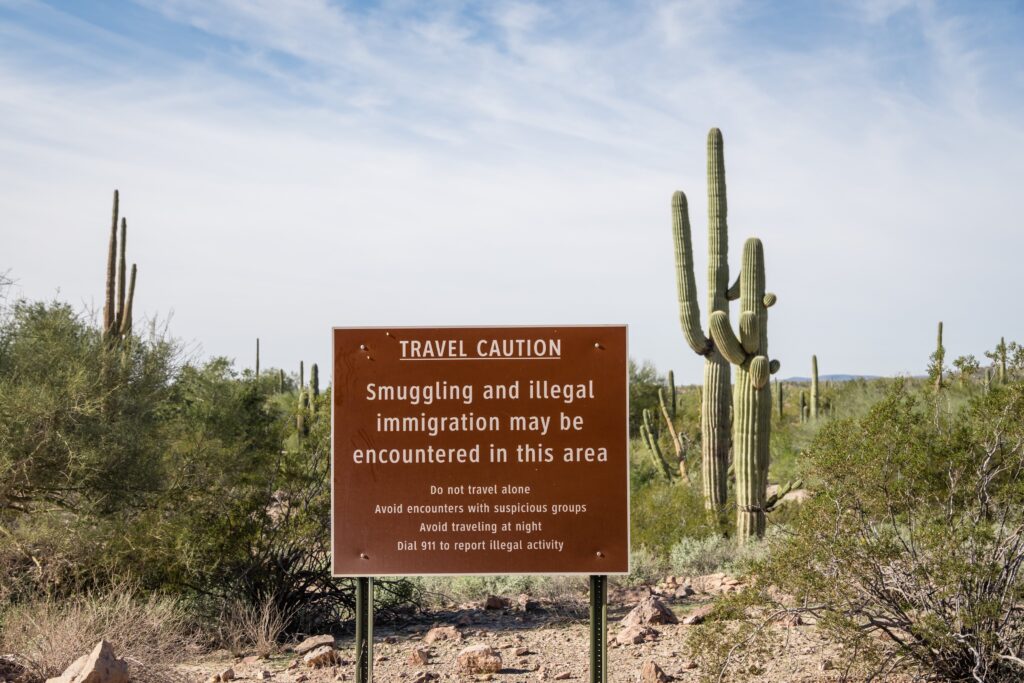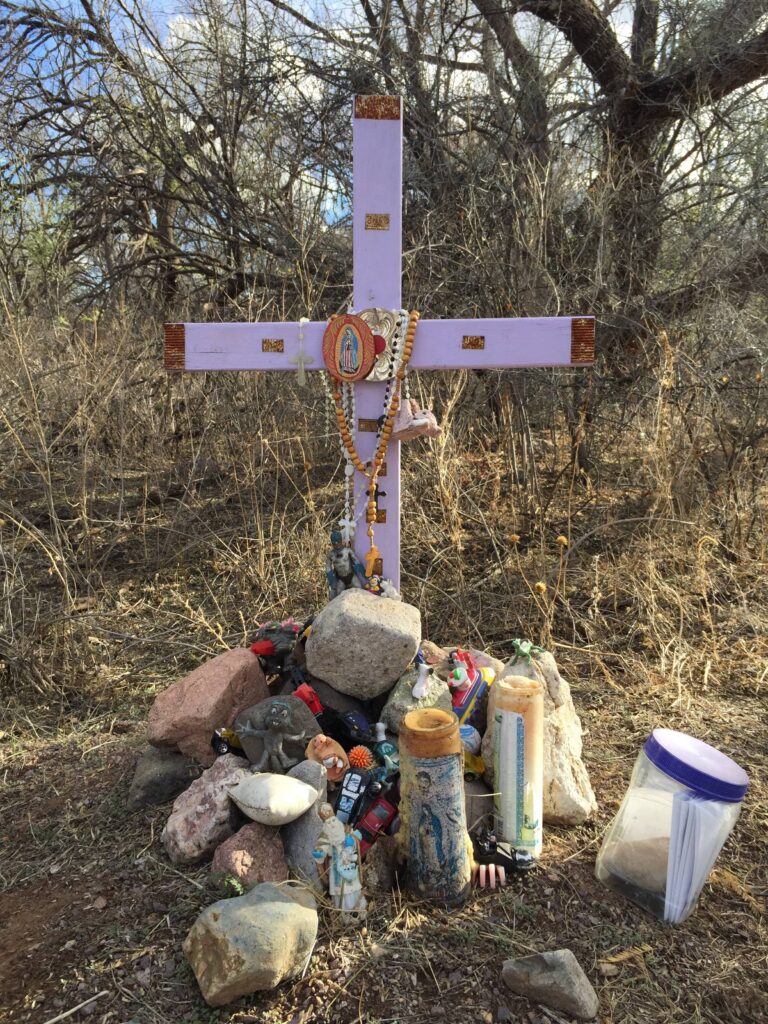
After Donald Trump’s 2016 presidential election win, an anthropologist set out across the U.S. to understand the nation’s deepening divides. In the new book Something Between Us, he grapples with these rifts and how to repair them.
Excerpted from Something Between Us: The Everyday Walls of American Life, and How to Take Them Down by Anand Pandian, published by Redwood Press, an imprint of Stanford University Press, ©2025 by Anand Sankar Pandian. All rights reserved.
It was a gorgeous winter day in southern Arizona, sunlight breaking through the clouds to catch the red earth and high grasses, an occasional saguaro cactus keeping watch from some high promontory. I’d gone out into the Sonoran Desert that day with a volunteer crew from the Tucson Samaritans, an organization that maintains water stations for migrants finding their way through that forbidding landscape. We walked along seasonal streambeds full of tattered backpacks, their polyester threads coming apart and mingling with the leaves and pebbles underfoot.
“There are so many stories,” one of the volunteers told me as we picked our way through thickets of scrub, leaving jugs of water and packets of food in places where people were known to rest.
The volunteer was a retired schoolteacher in her late 70s. Week after week, she came to these trails, carrying as much as her shoulders could handle, tending to the needs of people she almost never saw. As we headed back to Tucson that afternoon, I wondered about the yellow toy car she was holding in her hands. Then we pulled over beside a wooden cross, marking the place where a young woman was found stumbling down that road some years ago, a stillborn baby in her arms. Every time they passed this way, the former teacher explained, she would leave something here for that stillborn boy.
“All of us could have been someone else,” she told me. “What if I was walking in the desert, and I delivered this child? I’m taking care of him. I don’t want him forgotten.” (My gratitude to anthropologist Jason De León for introducing me to volunteers from the Tucson Samaritans. He writes about the significance of the organization’s care work and the difficult challenge of remembering those affected by the violence of U.S. border policy in The Land of Open Graves: Living and Dying on the Migrant Trail.)


The next day, I returned to the spot to pay my respects. A Border Patrol officer flagged me down at a checkpoint farther down the road, and we fell into conversation. The young officer told me that he’d sympathized at first with the people traversing these hills. Then it began to nag at him, the feeling they were lying about who they were, why they’d come. He knew the roadside cross; he’d driven past it many times but never stopped to take a look. “You get desensitized,” he told me. “You hear it often enough, and something in you shuts off.” ( See Francisco Cantú’s deeply affecting account of the psychic toll of Border Patrol work in The Line Becomes a River: Dispatches From the Border.)
The border guard cupped his fingers as he spoke these words, turning them in the air as if he was switching off a dial or turning the lock of an invisible door. A pair of sunglasses hid his eyes from view, mirroring the road back at me. We weren’t that far from the line of concrete and steel that marks the border in this region between the United States and Mexico. But the guard was speaking of another kind of border, a different kind of wall, one built not with mortar but mistrust.
Whether the plight of refugees or the recent COVID-19 pandemic, the climate crisis or systemic racism, so much turns on the care and concern we can muster for lives and circumstances beyond our own. And yet the deep divides of our national life in the United States have made effective action on such matters a serious and sometimes intractable challenge. Why is it so difficult to acknowledge and address the intertwining of our lives with others elsewhere?
It may be tempting to take such difficulties as a sign of moral or personal failure. But our feelings for others are structural realities as much as personal qualities. Ordinary environments and circumstances of life shape the possibility or impossibility of meaningful relationships, what we feel or can’t feel for others. Every means of isolation, whether grand or minuscule in scale, has a role to play in these dynamics. When others are experienced as distant abstractions, it’s easy to dismiss what they might say or need. At the same time, commitments to real relationships with others in a spirit of social solidarity and mutual aid—“where we choose to help each other out, share things, and put time and resources into caring for the most vulnerable,” as legal scholar and activist Dean Spade puts it—can change these difficult dynamics in profound ways.
Across the country in 2020, the pandemic spurred a return to socializing with neighbors on front yards and porches. Countless cities and towns carved out new places for walking, biking, and outdoor life—new ways of sharing public space with people both known and unknown. And movements for racial justice and solidarity with the vulnerable brought millions of people in the U.S. together that year and beyond, spurring more radical commitments to collective caretaking, redrawing the line between stranger and kin.
On one hand, the pandemic had supercharged an idea of the body as an armored enclosure to seal off against the dangers of the world beyond. On the other hand, calls abounded to redesign personal and public space for conviviality rather than isolation, for coming back into new ways of living more intentionally and meaningfully in the company of others. Even as the enduring strife of those years underscored the tenacity of political and social polarization in the United States, these small experiments in belonging suggested the genesis of something very different: “a vision of a different society,” as the abolitionist organizer Mariame Kaba put it, “built on cooperation instead of individualism, on mutual aid instead of self-preservation.” Such efforts anchor the vision of an alternative collective life that animates my new book, Something Between Us: The Everyday Walls of American Life, and How to Take Them Down.
Conviviality is a kind of “radical openness” in the social sphere, cultural theorist Paul Gilroy has argued, a rejection of the categorical divides that sustain racism, an ability instead “to live with alterity without becoming anxious, fearful, or violent.” Less a fantasy of social harmony under fraught circumstances, conviviality brings into focus ways of dealing with conflict and living at ease with difference through everyday circumstances of encounter and infrastructures of connection. Commons, parks, and open streetscapes; living quarters and resources arranged to encourage social awareness instead of solipsism; communication platforms to nurture contrary lines of thought: Such spaces can nurture the capacity to live and thrive alongside others unlike oneself, working against the tendency to reject and retreat.
These are possibilities with global significance. In recent decades, dozens of countries around the world have met aspiring migrants and refugees in need with fortified borders and imposing walls, marking continent after continent with lines that often reach hundreds of miles in length. Such gestures extend, to the largest scale, histories and patterns of enclosure that have accompanied the development of capitalist economies and individualistic societies over many centuries in Europe, the United States, and beyond.
In the face of such histories and their contemporary echoes, there is much at stake in learning to ask what kinds of boundaries are truly necessary and sustaining. As journalist Todd Miller puts it in Build Bridges, Not Walls: A Journey to a World Without Borders, “what kind of raw and beautiful world lies beyond the fences and walls that confine not just our bodies, but also our imagination, our speech, our very humanity?”
The promise of such a vision comes through with many of the people and stories I’ve encountered over the last eight years, through my fieldwork in more than a dozen states around the country in the aftermath of President Donald Trump’s first presidential election win.
Read on from the SAPIENS’ archive: “The Casual Menace of a Trump Rally.”
I think, for example, of the Black and White women of the Denton Women’s Interracial Fellowship who led a local struggle for desegregation in Texas in the 1960s, coming together in a north Texas town that had exiled its entire Black population just a few decades earlier. I think of Mark Baumer, a Providence, Rhode Island–based writer and activist who set out in 2016 to walk barefoot across the United States to protest the looming climate catastrophe. He perished in a tragic collision with an SUV in the Florida Panhandle, and yet his story invites a serious rethinking of our American streetscapes with his vision of a roadway hospitable to all living beings. And I think of Claire Coder, a young woman I met in Ohio who grew up on a daily diet of conservative talk radio, caught in the crossfire between a “liberal wahoo” mother and a father who’d condemn even the free pencils from elementary school as “government handouts.” She eventually left college to become a menstrual equity activist and helped coin one of the most popular slogans of the 2017 women’s marches: “Shed walls, don’t build them.”

“Some of the most difficult tasks of our lives are the claiming of differences, and learning to use those differences for bridges rather than as barriers between us,” writer Audre Lorde observed. These words remind us of a dissident heritage essential to the United States that we know now, the critical vision of those who have understood the occupation of this continent and its capitalist logic otherwise, those who have given voice to the possibility of more radical forms of collective life in this country.
In this spirit, throughout my book, I pay heed to the work of activists of many kinds—migrant and refugee advocates, feminist organizers, agitators for shared space, clean water, and safe roads—in order to consider what a more just and open U.S. society could look and feel like. Such work can help us imagine and cultivate social alternatives and unexpected forms of connection across the rigid lines many of us so easily take for granted.
There is no better way to learn once again how to meet strangers in this land as potential kin. We need to confront the many walls we’ve come to live with and what it could mean to take them down.
Editors’ note: This excerpt has been lightly edited for style, clarity, and length.
The post Reclaiming Collective Life in a Fractured U.S. appeared first on SAPIENS.